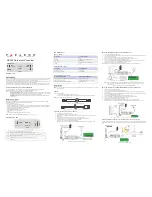
TSLv5
This protocol is a new 16-bit UMD protocol, with no reverse compatibility to previous TSL UMD
protocols. The primary points distinguishing this protocol from previous versions are as follows:
•
Display addressing up to 65,535 per screen
•
ASCII or Unicode character sets
•
Variable length mnemonics
•
IP based packet communication, with optional wrapper for stream based comms
•
Multiple display updates per packet
Physical Layer
Packets are sent via UDP. Maximum packet length is 2048 bytes. Optionally, the protocol can operate
over TCP/IP, or any other byte stream interface, with the following wrapper scheme:
DLE is defined as 0xFE
STX is defined as 0x02
Packet start is delimited by the sequence DLE/STX. Any occurrence of the DLE character in the packet is
byte stuffed to DLE/DLE. Any byte count fields in the packet are not affected by the byte stuffing.
Message Format
16 bit values are sent as little-endian, i.e. LSB/MSB.
The packet is defined as follows:
PBC / VER / FLAGS / SCREEN / (<DMSG> ( / <DMSG>)…) or (SCONTROL)
PBC
(16 bit):
Total byte count of following packet.
VER
(8 bit):
Minor version number (e.g. V5.00, VER = 0). This byte can be used as versioning control for the following
definitions. Whilst any future changes to this protocol will aim to be backward compatible, this is not
guaranteed.
FLAGS
(8bit):
Defined as follows:
Bit 0
Clear for ASCII based strings in packet, set for Unicode UTF-16LE
Bit 1
If set, data after SCREEN is screen control data (SCONTROL) – otherwise it is display message
data (DMSG)
Bits 2-7 Reserved (clear to 0)
INSTALLATION AND OPERATION MANUAL
Synapse MGU100 - MGG100 | Appendix 1: Supported Protocols |
49












































